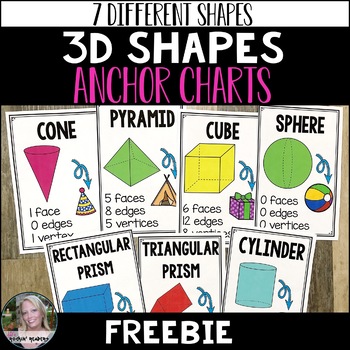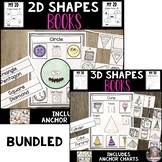JD's Rockin' Readers
21k Followers
Resource Type
Standards
CCSSK.G.A.3
CCSSK.G.B.4
CCSS1.G.A.1
CCSS1.G.A.2
CCSS2.G.A.1
Formats Included
- PDF
Pages
5 pages
JD's Rockin' Readers
21k Followers
Also included in
- Are you looking for an engaging way to teach your students all about shapes?This fun and interactive bundle of 2D Shapes Books and 3D Shapes Books are perfect for teaching children the names and attributes of different shapes. With each book, students will learn about 4 or 5 different shapes which tPrice $5.60Original Price $7.00Save $1.40
Description
These 3D Shapes Anchor Charts are a great way to display different shapes. They can be used as a reference for students. Each anchor chart shows the name of the shape, how many edges, faces, and vertices it has and shows a picture of a real-life object.
7 Shapes Included:
- Cone
- Cube
- Rectangular Prism
- Pyramid
- Sphere
- Triangular Prism
- Cylinder
If you LOVE these posters, you are sure to love these 3D Interactive Books as well!
Don't forget- leaving feedback earns you TPT credits toward free TPT purchases!
FOLLOW ME to be notified when new resources are uploaded AND I offer 50% off my products for the first 48 hours. It pays to follow.
ROCK YOUR LITERACY BLOCK!
Jennie
JD's Rockin' Readers
Total Pages
5 pages
Answer Key
N/A
Teaching Duration
N/A
Report this resource to TPT
Reported resources will be reviewed by our team. Report this resource to let us know if this resource violates TPT’s content guidelines.
Standards
to see state-specific standards (only available in the US).
CCSSK.G.A.3
Identify shapes as two-dimensional (lying in a plane, “flat”) or three-dimensional (“solid”).
CCSSK.G.B.4
Analyze and compare two- and three-dimensional shapes, in different sizes and orientations, using informal language to describe their similarities, differences, parts (e.g., number of sides and vertices/“corners”) and other attributes (e.g., having sides of equal length).
CCSS1.G.A.1
Distinguish between defining attributes (e.g., triangles are closed and three-sided) versus non-defining attributes (e.g., color, orientation, overall size); build and draw shapes to possess defining attributes.
CCSS1.G.A.2
Compose two-dimensional shapes (rectangles, squares, trapezoids, triangles, half-circles, and quarter-circles) or three-dimensional shapes (cubes, right rectangular prisms, right circular cones, and right circular cylinders) to create a composite shape, and compose new shapes from the composite shape.
CCSS2.G.A.1
Recognize and draw shapes having specified attributes, such as a given number of angles or a given number of equal faces. Identify triangles, quadrilaterals, pentagons, hexagons, and cubes.



